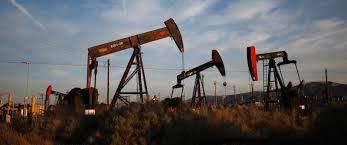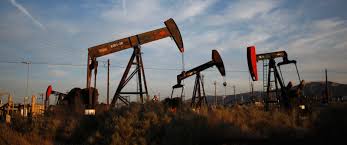
Traditional supply dynamics have been upended and forecasts have been made far more polarized by the shale oil boom which has transformed the U.S. and global energy sector.
Warnings that huge spending cuts caused by a plunge in oil prices since 2014 would lead to a supply crunch in the next two years have been given by investment banks, many of which finance new projects, along with oil majors such as Total and Eni.
A looming recovery in U.S. output on the back of higher oil prices combined with an avalanche of new conventional projects will create a substantial surplus by 2019, believes Goldman Sachs, the only bank to make more than $1 billion a year from commodities trading.
Conventional oil was the only game in town prior to the shale revolution. Factoring in the "unknown knowns" such as political risk in oil-producing nations and calculating the project pipeline are involved in estimating future supply.
Production cycles have shortened as fields can be switched on and off in a matter of weeks which has translated into the ability of the shale sector to adapt quickly and nimbly to a lower-price environment.
Shale's decline during the oil price collapse and its production increases as prices recovered was underestimated by most forecasters including OPEC and the International Energy Agency.
Complicating OPEC's efforts to rebalance the market and ease a global glut with the help of output cuts, Goldman predicts the coming two years will see a huge burst of development.
"This long lead-time wave of projects and a short-cycle revival, led by U.S. shales, could create a material oversupply in 2018-19," Goldman's equity research team said last month.
"As OPEC prepares for its May 25 meeting, it is likely to weigh the relative benefit of stability (extend cut) versus the risk of long-term share loss."
1 million barrels per day (bpd) to global supply by 2018-2019 could be added due to new projects and rising shale output, Goldman estimates.
Goldman's rival Morgan Stanley, which believes a surge in U.S. production this year will not derail the rebalancing contrasts the forecast along with those of consultancy Wood Mackenzie, which foresees a supply gap of 20 million bpd by 2025.
"OPEC has successfully constrained output, and although drilling activity in U.S. shale is picking up rapidly, this will probably not come quick enough to prevent a period of sizeable inventory draws late this year," Morgan Stanley said.
"By 2020, we estimate that (around) 1.5 million bpd of demand will need to come from projects that have not been sanctioned yet, but that have break-even oil prices of $70-75 a barrel," the bank said.
Before reverting to the contango structure of low prompt prices and higher futures prices that is typical of an oversupplied market as brent crude futures show prices for oil deliverable up to 2019 trading below those for prompt delivery.
Even though global crude inventories in developed economies alone top 3 billion barrels, supply and demand will fall into line this year as some 300 million barrels above the five-year average that OPEC is targeting with its supply cuts as Goldman stands by its prediction.
In order to cut output jointly by 1.8 million bpd for the first half of this year to tackle the overhang and agreement was reached between the Organization of the Petroleum Exporting Countries and some of its biggest rivals including Russia.
(Source:www.reuters.com)
Warnings that huge spending cuts caused by a plunge in oil prices since 2014 would lead to a supply crunch in the next two years have been given by investment banks, many of which finance new projects, along with oil majors such as Total and Eni.
A looming recovery in U.S. output on the back of higher oil prices combined with an avalanche of new conventional projects will create a substantial surplus by 2019, believes Goldman Sachs, the only bank to make more than $1 billion a year from commodities trading.
Conventional oil was the only game in town prior to the shale revolution. Factoring in the "unknown knowns" such as political risk in oil-producing nations and calculating the project pipeline are involved in estimating future supply.
Production cycles have shortened as fields can be switched on and off in a matter of weeks which has translated into the ability of the shale sector to adapt quickly and nimbly to a lower-price environment.
Shale's decline during the oil price collapse and its production increases as prices recovered was underestimated by most forecasters including OPEC and the International Energy Agency.
Complicating OPEC's efforts to rebalance the market and ease a global glut with the help of output cuts, Goldman predicts the coming two years will see a huge burst of development.
"This long lead-time wave of projects and a short-cycle revival, led by U.S. shales, could create a material oversupply in 2018-19," Goldman's equity research team said last month.
"As OPEC prepares for its May 25 meeting, it is likely to weigh the relative benefit of stability (extend cut) versus the risk of long-term share loss."
1 million barrels per day (bpd) to global supply by 2018-2019 could be added due to new projects and rising shale output, Goldman estimates.
Goldman's rival Morgan Stanley, which believes a surge in U.S. production this year will not derail the rebalancing contrasts the forecast along with those of consultancy Wood Mackenzie, which foresees a supply gap of 20 million bpd by 2025.
"OPEC has successfully constrained output, and although drilling activity in U.S. shale is picking up rapidly, this will probably not come quick enough to prevent a period of sizeable inventory draws late this year," Morgan Stanley said.
"By 2020, we estimate that (around) 1.5 million bpd of demand will need to come from projects that have not been sanctioned yet, but that have break-even oil prices of $70-75 a barrel," the bank said.
Before reverting to the contango structure of low prompt prices and higher futures prices that is typical of an oversupplied market as brent crude futures show prices for oil deliverable up to 2019 trading below those for prompt delivery.
Even though global crude inventories in developed economies alone top 3 billion barrels, supply and demand will fall into line this year as some 300 million barrels above the five-year average that OPEC is targeting with its supply cuts as Goldman stands by its prediction.
In order to cut output jointly by 1.8 million bpd for the first half of this year to tackle the overhang and agreement was reached between the Organization of the Petroleum Exporting Countries and some of its biggest rivals including Russia.
(Source:www.reuters.com)














